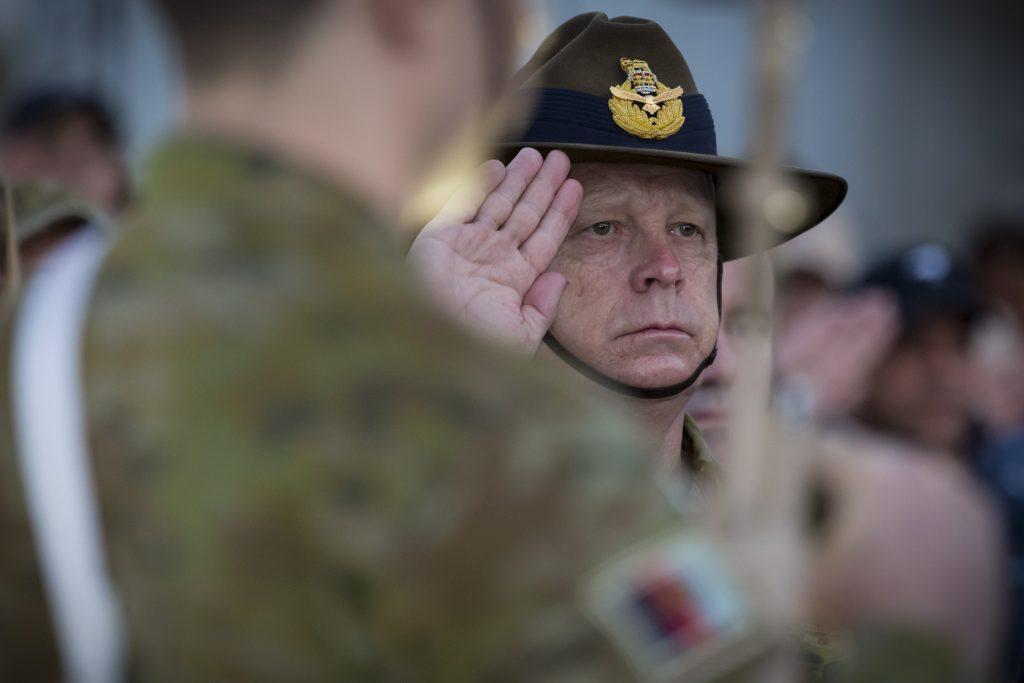Talking to the Chiefs: Mark Binskin
Posted By Brendan Nicholson on May 10, 2017 @ 11:00
In a village near the embattled Iraqi city of Mosul, Australian Defence Force chief Mark Binskin met a team of Australian combat medics who’d set up a triage unit and emergency operating theatre in a small house they’d found still standing in the ravaged landscape. They worked with another coalition medical team treating Iraqi soldiers wounded in the bitter, close quarters fighting against the Islamic State terror group.
In a forward operating base, soldiers from Australia’s Special Operations Task Group were helping members of Iraq’s Counter Terrorism Service plan operations and call in air strikes on enemy forces as they fought brick by brick through the ancient, narrow streets of Mosul’s Old Quarter. The Australian Special Forces had trained many of the Iraqis to deal with snipers, improvised bombs and medical emergencies. Relationships were close.
Air Chief Marshal Binskin was struck by the ingenuity the Australians had shown to significantly increase the Iraqis’ chances of survival in action and in the event they were wounded. It demonstrated to him that for all the ADF’s investment in $195 billion worth of new equipment over the coming decades, its real strength is its people, he tells The Strategist.
‘The biggest lesson is that it doesn’t matter what technology you’ve got, it’s your people that matter. It’s a capability issue for us to get the best people we can,’ Binskin says.
For 15 years the ADF has been on near-continuous operations overseas in different environments with different people, different languages and different enemies; Binskin says that experience has made its personnel highly adaptive. They need all of those skills in the very tough environment of Iraq.
‘We’ve selected and trained the right people and that’s where we’ve got our advantage—through their ability to innovate, to find the best way to respond to a problem regardless of the situation they’re in, whether it be targeting or helping the Counter Terrorism Service look after its wounded people. That investment in people is what gives you the best outcomes on operations. Give them the best equipment and they can do it. They know the rules, they know the procedures; they are well led or they are good leaders, and they know the bounds they need to operate in. They know the rules of engagement and they know how to operate within them to best effect.’
Binskin is very conscious of concerns about civilian casualties in Iraq and he says ADF personnel go to great lengths to prevent them through exhaustive planning. Many people don’t understand the constraints ADF personnel operate under and the discipline they bring to their work, he says.
‘There’s international law, domestic law, laws of armed conflict, rules of engagement, there are tactics, techniques and procedures they work within. They know they’ve got to be discriminate, they’ve got to be proportionate and there must be a military advantage in what we’re doing. If they’re part of a coalition; they know they are operating under our rules of engagement or the rules of engagement of the nation they are working with, whichever is the more restrictive. They have to take all of that into account. That’s alright in the planning but on operations they work within those rules in a dynamic environment to minimise civilian casualties and collateral damage.’
When air crews return from a strike, that’s not the end of it, says Binskin. ‘They go through the debriefing, through the tapes they’ve made during the strikes to make sure their assessment at the time is validated and make sure there was no damage that wasn’t catered for, there wasn’t a chance of civilian casualties.’ Binskin says:
‘If there’s an issue, the operation is reviewed and we take any lessons out of that. If there was a civilian casualty, that is reported up the chain and we then work with the Iraqi government. We haven’t had that yet but that’s how the procedure would work. It’s a complex targeting cycle and a complex environment out there and we’ve got great people in it at every stage to make sure that what we’re doing is not only within the rules, but it’s right.’
As technology in the ADF becomes more complex, Defence is increasingly competing with the private sector for smart, capable people. ‘We’re competing in the STEM area just like any other high tech organisation,’ he says. ‘I think we’re holding our own at the moment but we’re going to have to get better at it as those other areas are starting to compete more strongly for qualified people as well.’
Binskin says the modern soldier’s equipment has evolved a lot in 15 years but that probably hasn’t been noticed as much as other advances in military technology, except by the Diggers who’ve been part of it.
‘Now, each soldier needs to be considered as an individual weapons system. They’ve got a weapon, integrated communications, they’ve got electronic countermeasures and their body armour and all that needs to be considered as a total system. When they patrol they’ve got to prepare and ensure their electronic counter measures don’t jam their communications and they need to overlap each other with their ECM.’
As part of the process of recruiting the best, the cultural makeup of the ADF is changing and female participation is growing. About 30% of applicants are women. Around 5% of recruits are indigenous. More people aged between 25 and 35 are joining up and retention rates are high.
The ADF is trained for a wide range of tasks from aid to civilian communities in times of disaster such as fires and floods to relief operations in the region to high-end war fighting, if required.
‘We structure and train to cover all of that,’ Binskin says. ‘It’s a pretty potent and effective force.’
Article printed from The Strategist: https://aspistrategist.ru
URL to article: /talking-chiefs-mark-binskin/
Click here to print.
